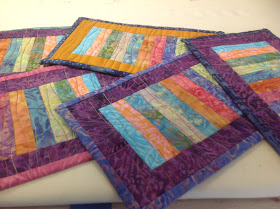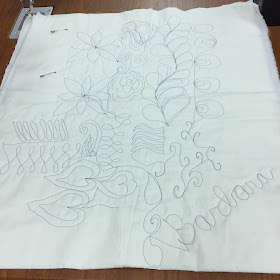I am a serious proponent of putting labels on all your quilts. In case of loss, you have a better chance of getting your quilt back. But more importantly, this is information someone in the future should want to know:
As soon as I finish a quilt, I write my name and the year on the back with an Ultra Fine Point Sharpie black permanent marker. No quilt leaves my home without at least this information on it.
Because I am a woman of many words, I want more information on my quilts so I print labels on my computer with the "who, what, when, where and why" on them. Information should include:
Who made this quilt--the top. If it was a group effort, explain that
Who designed it--the pattern designer/book author if it's not an original design
Why was it made--gift, celebration, commemoration, for love of the fabric or design
Who is it for--if being given directly to a person
Who quilted it--if not the maker of the top. That person deserves recognition
When--some of my labels show a range, the longest one says 2004-2011
Where--the maker and/or the recipient, where do they live
By preserving this information for your family now, the quilt may get more respect from future generations. Historians and collectors will thank you. One of my quilts that I made in 1995 says "to be given to the first of her sons to marry". My eldest son was 16 at the time. It is now the property of Andrew, my younger son, and a new label was added on the left corner. It has a dedication to my son and his bride, the date of their marriage and this--"To be handed down to the first of their children to marry." Long term thinking here.
There are several fabric products available to run through an ink-jet printer. Today I am using this, Printed Treasures:
Another favorite brand is
EQ Printables from Electric Quilt Company. I am out of that at the moment so will restock soon. These products are paper-backed 8.5" x 11" white fabric sheets that are designed to be run through an ink jet printer and the ink remains permanent, even through many washings. Do not use a laser printer--they print with heat and you could damage the printer. These products also come in "sew-on" and "iron-on" styles--I prefer the "sew-on"--it is softer and leaves no residue on the quilt.
If you have lovely handwriting, you can use any light fabric and a permanent pen to write your information on the quilt. My handwriting isn't very good so I prefer to print my labels.
I keep a running list of quilts that need labels and when I have enough to fill an entire page I make them. I work in Word but you could use Publisher or a greeting card template.
This time I had a label I wanted to add a photo to: Stella's Splendid Sampler. In October 2016 when she visited us at 16 months old, we spent some time looking at her quilt blocks on the design wall. She could point out specific things like a bird, a dress, a heart, a cupcake, a flower. I loved this shot of us and knew I would use it on her label. At first, this was to be her "big girl bed" quilt but it's pretty big so now I'm thinking it's more likely her dorm quilt, way in the future.
Here is the label after it came out of the printer. Read and follow ALL the directions. Double check your spelling, there is nothing more disheartening than a label with a misspelled word--ask me how I know:
Here I have cut the labels apart, the blank piece at the top may be a handwritten label later:
When I first starting using these products for labels I loved that I could put as much information as I wanted on the label. What I didn't love is that it was somewhat difficult to turn the raw edges over to needle-turn in place--the fabric is tightly woven so it holds the images/printing well. One day I had a label with very narrow margins, too small to turn under, so I added a border of the back fabric, using a 1/8" seam allowance and VOILA! Problem solved. From then on I have used the back fabric to create a frame around the label and it is as easy to stitch in place as any applique' would be.
Trim the label so it is neat and square--I try to have an equal amount of margin around the words. I cut the fabric strips about 1.25" usually. The left and right strips are the same size as the label, the top and bottom are about 1" wider than the label with the sides on will be:
First, I turn in one edge about 1/4". This is easy to do before sewing the strips to the label:
I sew the left and right sides in place using a 1/4" seam allowance usually. Sometimes there is not much margin--then I use a 1/8" seam allowance. Press the two sides away from the label and trim the ends even with the top and bottom of the label:
Sew the top and bottom strips on the label, centering the strips:
Turn the tails to the back of the label and press them firmly over the ends. I use a hot, dry iron for this. Then I use just a drop or two of washable glue, here is Elmer's washable school glue, but a washable fabric glue stick would work too. I put the glue on the folded over ends and use the hot, dry iron to dry the ends in place. I started doing this after finding it too fiddly to keep the ends nice and flat while sewing it to the quilt. This solution works great:
Now the label is pinned in place on the lower back, ready to hand sew in place, with thread that matches the back fabric, a bright pink in this case. It goes over my handwritten name and date:
There is one more photo of Stella enjoying this quilt as I was making it. In August 2016, when she was 14 months old, we had a family beach vacation. That week I was making the purple coneflower with hand applique'. When it was done I showed it to her as her Pop Pop held her and she made her "face of the week"--her "surprised" face:
That's my girl!
Don't let your quilts leave home without a label.
Let's quilt!
Barbara





















































